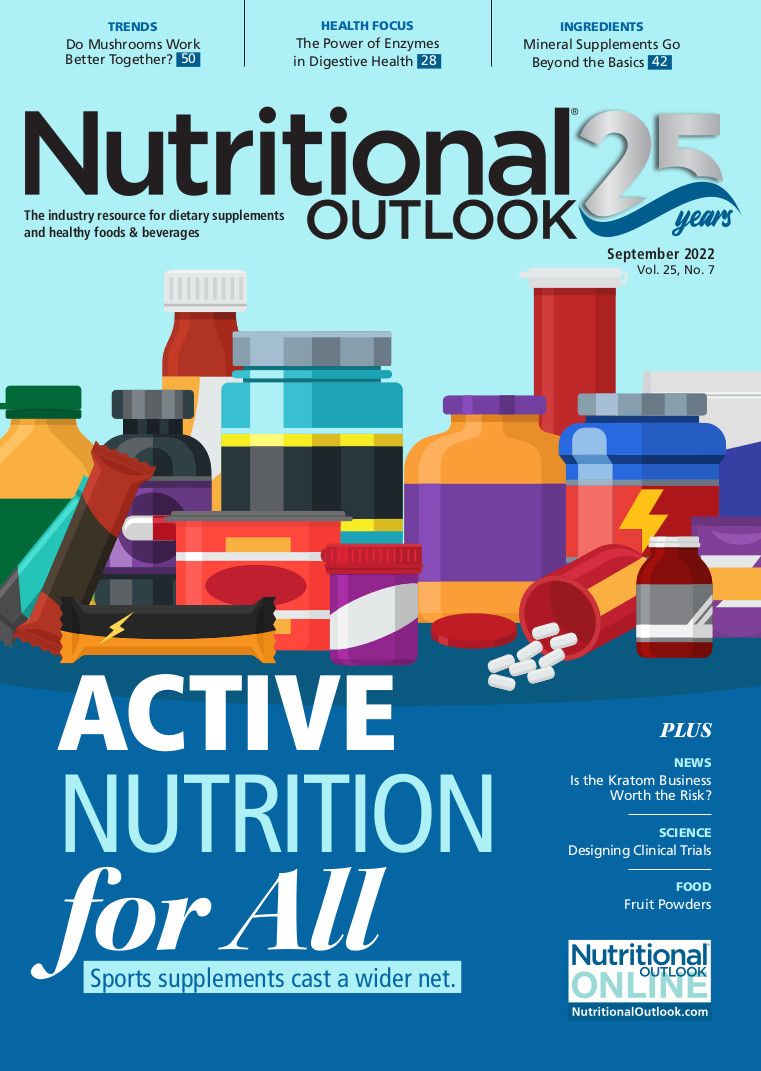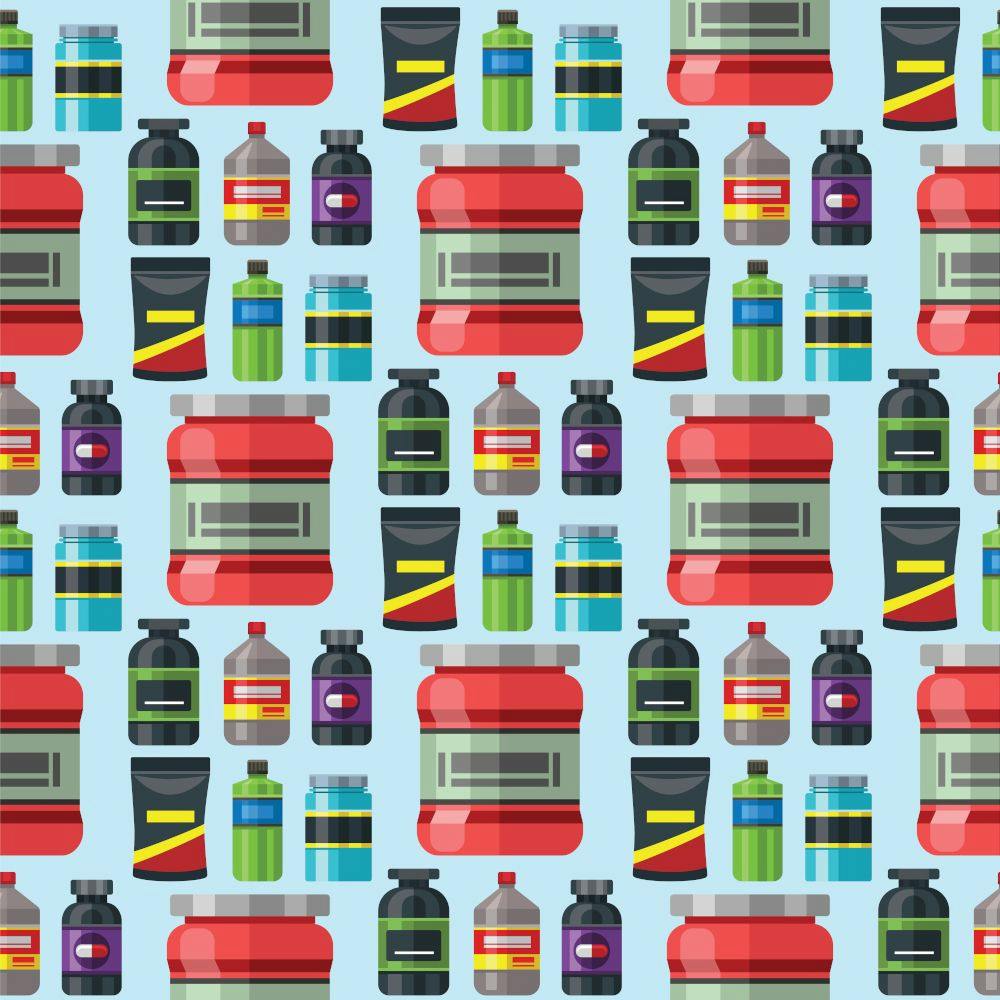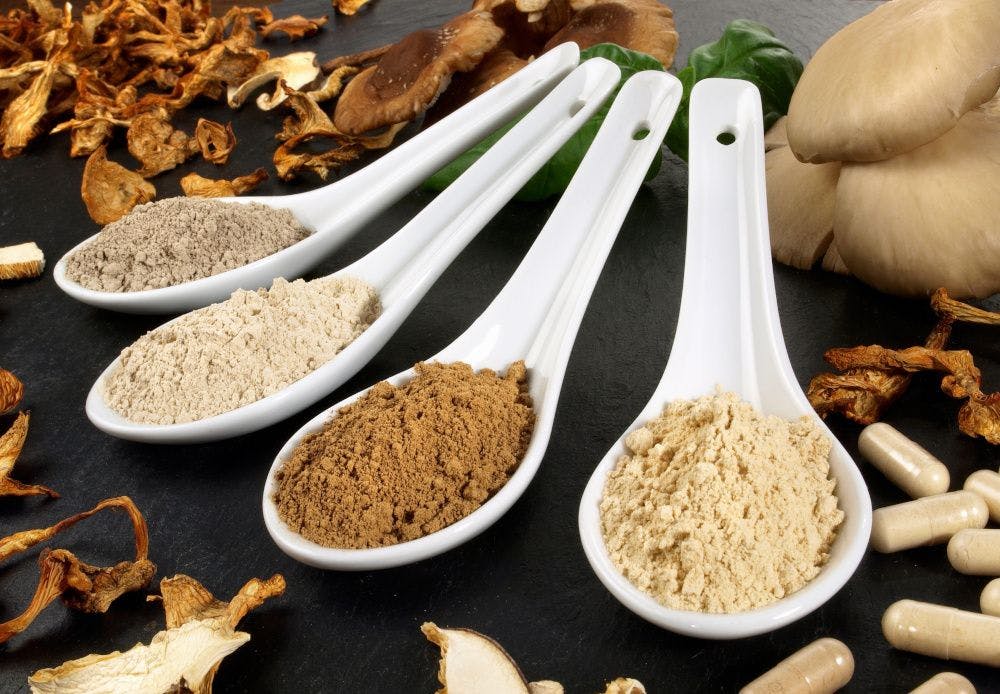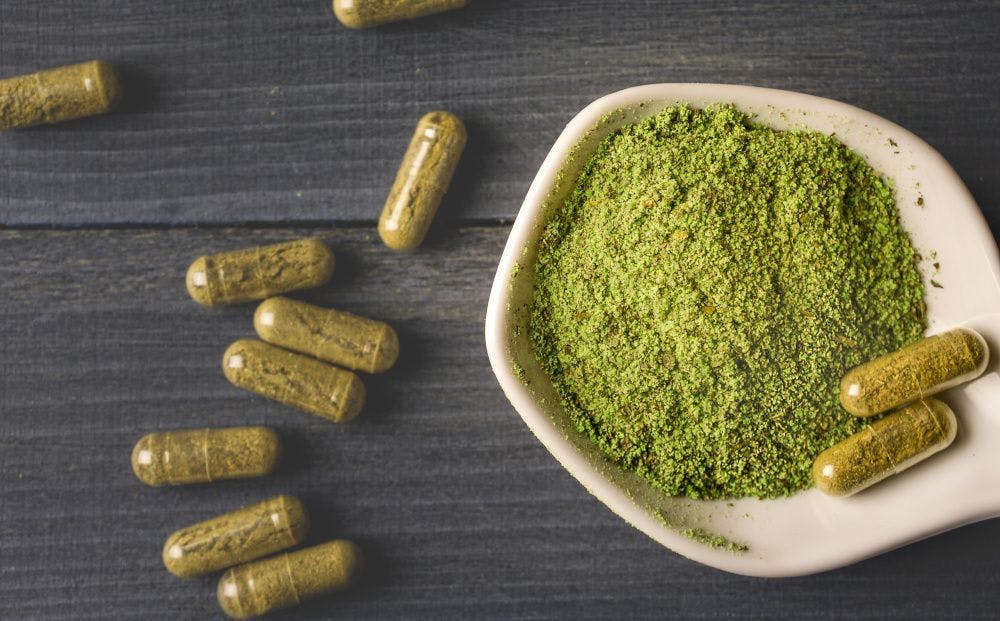Active nutrition for all: Sports supplements court a broader audience
As consumers get active post-pandemic, they’ll find a wider range of sports supplements ready to cater to their every need.
Photo © Creativeteam - Stock.adobe.com

There was a time in the supplements industry, not so long ago, when the biggest public controversy centered around professional and Olympic athletes—those who knowingly cheated using supplements laced with sports-banned ingredients to get ahead of competitors, and those who, perhaps accidentally, fell into controversy only to call foul on the companies supplying or manufacturing the products.
Bulked-up bodybuilders were the face of the sports supplement category, and whether one was impressed or not with the physical results, it seemed unlikely that legal ingredients were creating the pictures seen in magazine advertisements.
For sure, bodybuilders are still an important customer for many companies in the industry, but they’re no longer the only customers in a category that is constantly reinventing itself.
One might say it’s now a kinder, gentler category, where plant-based nutrition thrives and consumer interest in clean label is widely accepted, as is a shift in the consumers that companies are now courting.
Chris Sadewasser, global products manager at Kemin Human Health & Nutrition (Des Moines, IA), points to a report from Mordor Intelligence citing the main driver for the category’s large growth as “the shift to be more inclusive of all recreational and lifestyle users in the market, instead of a specific focus on high-performance athletes.”1
And unlike in previous years when the old sports-related category was dragging the rest of the industry down, it’s now lifting the market up.
“We see an incredible increase in the products targeting the active nutrition category,” says Shawn Baier, MS, MBA, vice president of business development at TSI Group Ltd. (Missoula, MT). “Taking supplements has never been more widely accepted, and this is thanks to the growth of the active nutrition category.”
A Market Primed for Growth
“The active nutrition category is seeing significant growth over the last few years,” says Sadewasser. According to 360 Research Reports, the global active nutrition market is projected to grow at a CAGR of 12.3% from 2021-2026, he notes.2
Marianne McDonagh, vice president of sales at Bioenergy Life Science Inc. (Ham Lake, MN), says this category represents a lucrative opportunity, with both consumer awareness and product innovations contributing to its growth.
“Consumers have always wanted to live healthier lives,” says McDonagh. “Now they’re serious about taking the steps which include educating themselves about the science and efficacy of products’ ingredients.”
Lindsey Toth, director of global marketing at Lonza Capsules & Health Ingredients (Greenwood, SC), observes that “people across all ages and demographics are ready to get moving again, which means the active nutrition category is expanding and evolving. New consumers entering the active nutrition space are involved in a broad range of activities and seek a variety of performance goals.”
TSI’s Baier agrees that consumers are looking for products that contain functional ingredients that support their healthy lifestyle on a daily basis. He further believes that “they expect to see the positive results promised on the label. The growing consumer interest is driving innovation and research in this category,” he says. “Additionally, new delivery forms play an important role in the success of new launches, and the quality of ingredients in these products is also playing a crucial role in their acceptance and success.”
Not even a global health pandemic could take this category down—although for a while it appeared it might. According to Katie Emerson, MS, RD, LDN, manager of scientific affairs at Nutrition21 (Purchase, NY), “The active nutrition category is alive and well post-pandemic. Evolving from sports nutrition with a tight focus on athletes, active nutrition is a broader category that captures consumers who have an interest in being active but not necessarily ultra-competitive.”
Emerson explains that the active nutrition consumer focuses on being active and incorporating better nutrition in his or her life. And, she adds, an October 2021 report on active nutrition from FMCG Gurus reported that more than half of the population falls into this group.3
The Holy Grail of Holistic Health
Holistic is a not a word that many would have associated with prior iterations of the sports nutrition category. However, if there is one thing that companies in this market have demonstrated, it’s that they’re adaptable and responsive to moving the playing field to where consumers are going.
Toth advises that regardless of the targets that individuals set for performance goals, “there is a growing focus on achieving these goals through overall wellbeing.” She adds that “this year, we expect that active nutrition will increasingly overlap with other supplement categories as more consumers explore complementary benefits like better sleep, joint health, weight management, immune support, and stress management.”
Sadewasser, too, sees consumer attitudes changing toward this category. “As this category continues to grow and shift away from a focus on sports nutrition to more holistic health,” he says, “we may begin to see a demand for products that meet up-and-coming consumer demands such as sleep or mood support.”
Gone is the attitude of Billy Crystal’s 1980s Saturday Night Live send-up of Fernando Lamas. For this category, it’s no longer just about “looking mahvelous;” it’s about making you feel that way.
As Emerson explains, “The product solutions for this crowd are also broad, serving everyone from those who want to maintain their physical fitness to those who aim to support their cognitive wellbeing, and everyone in between. These days, it’s as much about feeling physically fit as well as mentally fit.”
The Rise of Functional Ingredients
Taking its cue from consumer demand and the success of other supplement and functional food categories, active nutrition companies are proactively riding the wave with ingredients that support more than just sports goals. Today, they are looking for ingredients that also acknowledge immunity, digestive health, mental acuity, cellular health, and more.
With regard to functional ingredients and the active nutrition consumer, Sadewasser sees research showing that this population wants to be more proactive with its health and wellness.3 He cites findings from market researcher FMCG Gurus indicating that, historically, consumers have focused on their nutrition during times they are pursuing a particular health goal for a set period of time, such as weight loss or sports nutrition. Today’s active nutrition consumers want more from their supplements, especially since COVID, in order to maintain a healthy lifestyle.3
In particular, notes Sadewasser, immunity and digestive health are two areas consumers hone in on when it comes to life improvements.3 And they are showing more interest in ingredients like Kemin’s branded ingredient BetaVia, a beta-1,3 glucan derived from algae to help support both immunity and gut health.
Probiotics are another. “Gut health ingredients like probiotics are making waves in active nutrition, and we expect this to continue throughout 2022 and beyond,” adds Toth. “Probiotics have been gaining consumer attention for many years thanks to their positive effects on gut health. Still, scientists have recently discovered even more ways for probiotics to support health with benefits for athletic performance and exercise endurance.”
Lonza’s TWK10 sports probiotic, originally sourced from Taiwanese kimchi, has been shown to increase circulating blood glucose levels during exercise for improved muscle endurance and, according to a company press release, is the first probiotic clinically studied to show an increase in exercise endurance by up to 75%.4,5
Last July, Lonza announced that Kaged Muscle would be the first brand to launch with the TWK10 Sports Probiotic in the U.S.4 Earlier this year, Lonza extended the ingredient to the European market.6 Toth says that “the preliminary data [from the European launch] is very promising. This comes as consumer awareness of probiotic solutions and their potential applications in active nutrition continues to rise.”
In fact, Toth adds, unpublished data from Lonza’s research found that three in four people are looking for a probiotic solution that is effective in supporting athletic and muscle endurance and improving both body composition and natural energy levels.7
Stimulation Without Stimulants
Two companies with branded ingredients—and recent scientific research to report—are focused on the trend of energy without the jolt.
Or, as TSI’s Baier puts it, “non-stimulant sources of energy.” He says, “We see the consumer awareness of the term energy being challenged to depict ‘true energy’ more accurately versus a supplement with a stimulant effect.”
TSI’s Peak ATP is a non-stimulant energy source that fuels muscles and powers the body’s movement. A company press release explains that it is a clinically validated and patented form of adenosine-5’-triphosphate (ATP) disodium that is identical in structure to ATP produced and used by the human body.
An unpublished, randomized, placebo-controlled, dose-ranging crossover study conducted by researchers at Brazil’s Federal University of Piauí evaluated the benefits of 100-, 200-, and 400-mg doses of Peak ATP in 20 recreationally trained men in their late 20s. The results showed, among other findings, that a single 400-mg dose of Peak ATP improved lower-body resistance-training performance and energy expenditure, increasing the number of set 1 repetitions by 13% and numerical increases in total repetitions by 7%. The ingredient was administered orally as a premix powder.8 TSI’s press release indicates that this study confirmed results from two previously published clinical studies that showed that acute, one-time supplementation with Peak ATP has significant benefits for athletic performance.
“From gamers to active lifestyle consumers, there is a growing interest in energy that is ‘real’ functional energy and not a stimulatory effect that is often short term and comes with unwanted side effects,” says Baier. “The active nutrition category is being challenged to deliver products that provide non-stimulant sources of energy.”
More Scientific Benefits from Steady Stimulation
Nutrition21’s Emerson says, “Supplying active nutrition consumers with the energy and stamina to get through their workout is important, but making sure they continue to maintain that same level of energy throughout their day is key.”
This is why, she states, “Caffeine and other jittery ingredients are taking a backseat to those ingredients that provide a more sustainable form of energy that keeps active nutrition consumers performing at their best long after their workout has ended.”
Nutrition21 has two such non-stimulant branded ingredients relevant to the active nutrition category: its patented complex of bonded arginine silicate, Nitrosigine, and its nootropic ingredient nooLVL, a patented complex of bonded arginine and silicon with an optimized dose of inositol. Both have recent science to report.
Adding to the body of scientific research on Nitrosigine is a “…recent study designed to show how Nitrosigine works on cognitive functions, such as memory, attention, language, and processing speed, among other areas,” says Emerson.
The double-blind, crossover, placebo-controlled study was conducted in 16 healthy adults ages 18-28 during two separate trials, each of which were approximately three hours in length. The results showed that immediate memory performance in the Nitrosigine group (1.5 g plus 8 g of dextrose) significantly improved (27%) compared to the placebo group (8 g of dextrose).9,10
Further, Nitrosigine maintained delayed memory scores in comparison to the placebo group, for which delayed memory scores decreased. And in a third cognitive function test, Nitrosigine also significantly increased the total scores for Repeatable Battery for the Assessment of Neuropsychological Status (RBANS) with an 11% increase.
Meanwhile, at this year’s Experimental Biology conference, new research in healthy adult males and females ages 18-32 who received 1600 mg of nooLVL for seven days was presented at a poster session. In the study, each subject was asked to take multiple computer-based cognitive performance tests through the Cambridge Brain Sciences platform at baseline prior to supplementation, on day 1 after a single dose of nooLVL, and on day 7 after daily administration of the supplement, says Emerson.11
She advises that results show that nooLVL led to significant improvement on measures of attention/concentration, visual representation, and forethought/sequencing.
Other Companies See Esports As an Up-and-Comer Worth Betting On
“Another area that is gaining momentum is in the area of esports,” declares Kemin’s Sadewasser. “Based on the environment that many egamers are in, with prolonged time in front of digital devices, protection against blue light is a very important aspect to the long-term health of their vision.”
Blue light passes through the cornea and lens and reaches the retina, Sadewasser explains. Blue light also affects the quality of vision and is associated with reduced contrast sensitivity (the ability to see contrast between two objects), blurred vision, increased glare disability, and visual strain, all important aspects potentially impacting the effective and long-lasting gaming performance.12 Kemin’s FloraGlo lutein and Optisharp/ZeaOne natural zeaxanthin ingredients are clinically proven to enhance the quality of vision and visual performance, he says.
Lonza’s Toth also considers esports nutrition to be a highly promising offshoot of the traditional active nutrition space, one that is demonstrating tremendous growth potential. “Just as in traditional sports, esports athletes work hard to reach peak physical and mental performance, bringing in a new, fast-growing group of consumers seeking support to reach their gaming goals for nutrition brands,” she says.
And the good news: “With the esports market poised to hit $1.8 billion in global revenue this year13, now is the time for brands to tailor their nutrition solutions to get ahead of the game in this growing category,” Toth states.
Better for You, Better for the Planet
The active sports nutrition category is not immune to the growing interest from consumers in finding healthy nutritional products that also address planetary sustainability.
“Consumers are seeking out sustainable and transparent brands,” Sadewasser says. He shares that a survey conducted by IBM’s Institute for Business Value (IBV) showed that 93% of global respondents said the pandemic influenced their views on sustainability. Environmental issues have become even more important to consumers. IBV found that “49% of consumers say they’ve paid a premium—an average of 58% or more—for products branded as sustainable or socially responsible in the last 12 months.”14
Consumers are becoming more invested in sustainability, and that is starting to show with their purchases, he says.
Emerson agrees, advising that “some of the types of products active nutrition consumers are seeking out, according to FMCG Gurus, are those geared toward low- to no-sugar hydration, natural energy, fortified snacks, and healthy fats.”
And one thing that Lonza’s Toth says her company learned from its TWK10 sports probiotic launch in North America is that it “…confirmed for us the trending interest from consumers in clean-label, plant-based solutions.”
Two Goats Walked into a Sports Bar…
What happens when two goats join the party? If we’re talking about these kinds of GOATs (Greatest of All Time), they appear to be a welcome addition.
Tom Brady’s TB12 is the epitome of a holistic company designed to “eliminate pain, prevent injury, and improve performance using healthy daily habits proven by” football’s arguably winningest quarterback of all time. Protein products and other supplements are just one of the pillars of what Brady’s selling, teaming with other important categories of wellness like mental fitness, movement, and nutrition.
LeBron James, with his three-time National Basketball Association (NBA) championships and four-time NBA Most Valuable Player trophies, joined forces with former governor and bodybuilder Arnold Schwarzenegger to create Ladder, a “sports nutrition company dedicated to creating high-performance, NSF Certified for Sport workout supplements for daily use.” Ladder recently launched Superfoods Greens, a vegan, gluten-free supplement boasting great taste, clean ingredients, and no artificial flavors or sweeteners.
Perhaps this is one more indicator that the controversies from former days relating to athletes are no longer subverting the category, and that winning is part of the category’s future.
The supplements industry welcomes these celebrity-backed brands, as they “bring awareness to this market and are at the forefront of the growth within this space,” says McDonagh. Bioenergy Life Science’s own branded ingredients offering benefits for the active nutrition category include RiaGev, Ribose, and RiboActiv.
McDonagh advises, however, that [category] growth “…is dependent on what these celebrity-backed products look like in terms of ingredients used, delivery method, and science.” She adds that during Bioenergy Life Science’s more than 30-year history, the company “has worked with many celebrity-backed brands as well as celebrity athletes themselves. We have nothing but positive things to say about the athletes and the products they support. Most of these celebrities take their health very seriously, as they should, and they value the support and the science we, as branded ingredient manufacturers, provide.”
TSI’s Baier, too, finds that celebrity-backed brands bring value to the category by making daily supplementation mainstream. “Putting a face behind a brand has always been a great marketing strategy, and the success of these brands only further proves it. If consumers see their favorite athlete, influencer, or actor take supplements as part of their daily regimen, they will want to mimic this behavior.”
He also points to the large social media following that comes with celebrity-backed brands. “Social media plays a great role in the success of celebrity brands, and that is something we can all learn from. Social media is ever evolving, but it will not be going away. Having a strong presence and an engaged audience is an important factor for the growth and success of all brands and companies,” he states.
The “T” in SWOT
Although threats to the sports nutrition category no longer loom as large as they once did, companies want to keep things on the upswing.
For example, Kemin’s Sadewasser says that “the main threat in the active nutrition industry is just the shift of consumer priorities itself. If consumers decide active nutrition is no longer important to them, that could lead to a decline in the market. However, since the market is shifting to a more holistic-health approach, it is likely it will stick around for a while.”
One thing that Bioenergy Life Science takes seriously is the need for science and efficacy to continue to be the driving forces behind this category, something McDonagh says “is, and will always be, the heart of our company.”
When talking about potential threats to the active nutrition category, McDonagh reminds us that “consumers are wary of unsubstantiated product claims.” She adds that “we understand the need to both support our customers as well as consumers’ wellbeing by providing significant and ongoing scientific evaluation.” In addition to the “overwhelming trust in Bioenergy Ribose built over the last 30+ years,” she notes that this summer “our first proof-of-concept human trial studying the benefits of RiaGev,” a healthy aging ingredient, was published in journal Nutrients.15 The randomized, triple-blind, placebo-controlled crossover pilot study in 50 healthy men and women between the ages of 36 and 65 found that the combination of nicotinamide and D-ribose (a 1520-mg dosage of RiaGev) supported healthy levels of nicotinamide adenine dinucleotide (NAD+) metabolomes.
TSI’s Baier reminds companies not to lose focus on quality. He sees “the biggest threat [to the category as] the lack of ingredient and product quality.”
He adds: “Quality issues are too common. With the pressure of this category’s growth and so many new brands and products launching, quality has taken a back seat.”
He observes that “we do see that consumers are becoming more aware of this problem and are requiring brands and companies to show proof of the quality controls as well as substantiated efficacy claims. Hopefully, this trend will continue to push the industry in the right direction.”
References
- Mordor Intelligence report. “Global Active Nutrition Market – Growth, Trends, COVID-19 Impact, and Forecasts (2021 – 2026).”
- 360 Research Reports report. “Global Active Nutrition Market Report, History and Forecast 2015-2026, Breakdown Data by Manufacturers, Key Regions, Types and Application.” Published August 27, 2020.
- FMCG Gurus report. “Active Nutrition vs. Sports Nutrition in 2022 – Global Report.” Published February 2022.
- Press Release. “Kaged Muscle First to Launch with Lonza’s TWK10 Sports Probiotic in the USA.” Posted July 1, 2021.
- Huang WC et al. “Effect of Lactobacillus plantarum TWK10 on improving endurance performance in humans.” The Chinese Journal of Physiology, vol. 61, no. 3 (June 2018): 163-170
- Grebow J. “Lonza Makes TWK10 Sports Probiotic Available in Europe.” Nutritional Outlook. Published February 23, 2022.
- Data from Lonza. U.S. sports nutrition supplement users via Suzy; n=1,000; 2020. Unpublished.
- Press Release. “Dose-Ranging Study Confirms that 400 mg of Peak ATP uniquely and acutely improves exercise performance.” Released October 2021.
- Blatman J. “How to Win the Sports and Active Nutrition Game in 2022.” Nutritional Outlook. Published March 28, 2022.
- Press Release. “University of Arkansas Publishes a New Study on the Cognitive Benefits of Nutrition21’s Sports Performance Ingredient, Nitrosigine.” Posted December 21, 2021.
- Press Release. “New Study Presented at Experimental Biology (Poster: E380) Shows nooLVL Improves Cognitive Functioning in Esports Gamers.” Posted April 8, 2022.
- Blog. “How Do Video Games Affect Your Vision?” Rebuild Your Vision LLC website.
- Newzoo report. “Global Esports & Live Streaming Market.” (2021). Global Esports & Live Streaming Market Report.
- Cheung J et al. “Balancing Sustainability and Profitability.” IBM report. Published April 7, 2022.
- Krawiec S. “Formulation of Nicotinamide and D-Ribose May Support NAD+ and Blood Glucose Levels, Says New Study.” Nutritional Outlook. Published July 11, 2022.





















